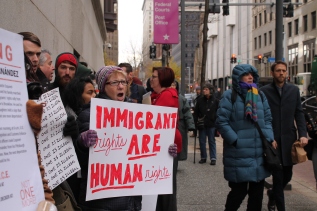January 13, 2017
By Jacqueline Souza

Direct Action for #BringMartinHome campaign. Photo by Marni Fritz
Due to the tumultuous U.S. campaign season and victory of President-elect Donald Trump, we have seen an influx of people creating and participating in direct action protests. Joshua Russell of activist blog Beautiful Trouble describes direct action as “collective action [that is] taken to change circumstances, without handing power to a middle person.” This protest method is well exemplified in the thousands of recent marches in solidarity with the Black Lives Matter movement, demonstrations against the construction of the Dakota Access Pipeline, and nationwide protests against the defunding of Planned Parenthood facilities, all of which have become more frequent in the wake of President-elect Trump’s candidacy and subsequent election. These protests have been predominantly nonviolent, though that does not eliminate the risk that activists take upon participating. Writers from ACT UP New York clarify that “the strength of nonviolence comes from [one’s] willingness to take personal risk without threatening other people.”Though efforts of direct action seem to be ubiquitous, do they actually incite change?
If we look back into our national history, we know that mass direct action is an effective way to spread a message and expand activists’ platforms. Washington D.C. alone has seen some of the most impressive protests- in 1971, nearly two hundred thousand people met to advocate for an end to the Vietnam War, and nearly two decades later, half a million members of the LGBTQ+ community gathered to fight for equal rights and government action pertaining to the national outbreak of HIV/AIDS. Direct action happens on a smaller scale in other locations across the country- for example, Reverend Doctor William Barber, an evangelical preacher from North Carolina, is responsible for the creation of regular “Moral Monday” protests during which attendees advocate for progressive legislation in the swing state. If nothing else, people who attend these demonstrations come away with a strong sense of solidarity and confirmation that their experiences are important and valid. With dedication and persistence, direct action movements can catalyze real legislative change.
However, there are even more ways to get involved in between important protests that entail less personal risk. Volunteer for organizations that tackle important social justice issues. Donate to those organizations. Contact your local and state representatives. Create a space in your social circles where education and awareness are promoted, and where curiosity is encouraged, not diminished.
Categories: Community Organizing, News, Protesting, Student Activism

